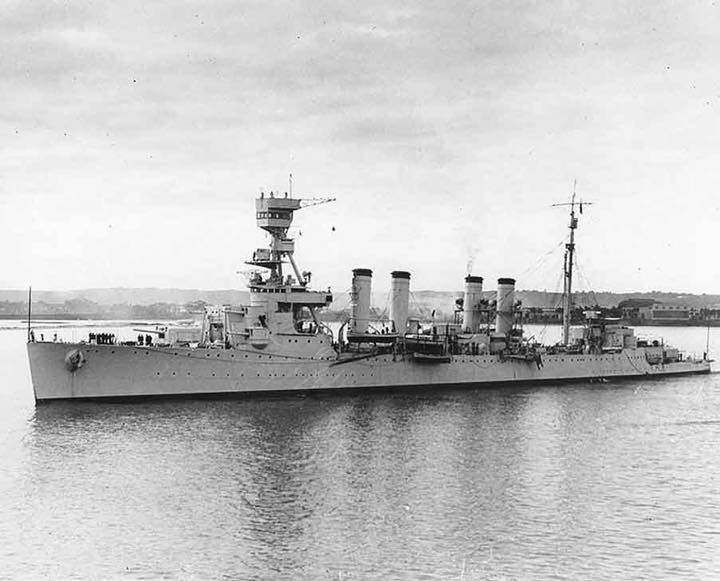USS Detroit CL-8

Detroit IV
(CL-8: dp. 7,050; 1. 666'6"; b. 66'4"; dr. 13'6"; s.
34 k.; cpl. 468; a. 12 6", 4 3", 10 21" tt.; cl. Omaha)
The fourth Detroit (CL-8) was launched 29 June 1922 by Bethlehem Shipbuilding Curp., Quincy, Mass.; sponsored by Miss M. Conzens, daughter of the Mayor of Detroit, Mich., and commissioned 31 July 1923, Captain J. Halligan, Jr., in command.
After a shakedown cruise to the Mediterranean Detroit joined the Scouting Fleet for exercises and maneuvers along the east coast and in the Mediterranean. In September and October 1924 she was on lifeguard station for the Army round-the-world flight, then served as flagship for Commander, Light Cruiser Divisions, until 23 November. After overhaul at Boston, she sailed 2 February 1926 for the west coast and fleet maneuvers along the coast and in Hawaiian waters. She returned to Boston 10 July 1926 with the Scouting Fleet.
As flagship for Commander, Light Cruiser Division 3, between July 1926 and March 1926 and between July and December 1926, Detroit continued to participate in maneuvers and fleet problems along the east coast and in the Caribbean. During March-April 1927 she patrolled off the coast of Nicaragua to protect American interests during political disturbances there.
Detroit sailed from Boston 16 June 1927 as flagship for Commander U.S. Naval Forces in Europe. She made goodwill visits to various ports in Europe, North Africa, and the Middle East, and received official visits from the Kings of Norway, Denmark, and Spain, and the President of the Irish Free State. She also transported Secretary of State F. B. Kellogg between Ireland and France for the talks which led the following year to the signing of the Kellogg Briand peace pact.
The cruiser returned to Norfolk 12 September 1928, for duty with the Scouting Fleet, serving as flagship for Commander, Light Cruiser Divisions, from 6 July 1929 to 29 September 1930. In January 1931 she sailed for a combined fleet problem off Balboa, then became flagship for Commander, Destroyer Squadrons, Battle Force, on 19 March 1931, based on San Diego. Detroit's operations included exercises along the west coast and maneuvers in Alaskan and Hawaiian waters. Except for a fleet problem in the Atlantic in 1934 she remained in the Pacific with the Battle Force, operating from her base at San Diego.
In 1941 Detroit's home port became Pearl Harbor. She was moored at her base with Raleigh (CL-7) and Utah (AG-16) when the Japanese attacked 7 December. The other two ships bore the brunt of an attack by six torpedo planes, and despite several strafing passes Detroit was able to get underway safely and set up an antiaircraft fire which accounted for several planes. She was ordered to sail at once to investigate the west coast of Oahu for any indications of a landing by the Japanese, then to join the search for the retiring Japanese force.
Returning to Pearl Harbor 10 December 1941, Detroit took up convoy escort duty between her home port and the west coast. On one of these voyages she took on board 9 tons of gold and 13 tons of silver from Trout (SS-202) who had evacuated it from Corregidor and delivered the bullion to the U.S. Treasury Department at San Francisco. In September 1942 Detroit escorted two convoys to Pago Pago, Samoa, rescuing the crew of a downed PBY during one passage.
Detroit sailed from San Francisco 10 November 1942 for Kodiak, Alaska, to become flagship for Commander, Task Group 8.6, and patrol between Adak and Attu to prevent further enemy penetration of the Aleutians. On 12 January 1943 she covered the unopposed landings made on Amchitka to gain a base from which to cut the Japanese supply line, and after repairs at Bremerton in February and March, returned to patrol duty to intercept reinforcements trying to reach the Japanese garrisons on Kiska and Attu. In April she bombarded Holtz Bay and Chicago Harbor on Attu, returning the next month to join in the assault and capture of the island. In August she took part in the bombardments of Kiska, then covered the lands 15 August which revealed that the island, the last outpost held by the Japanese in the Aleutians, had been secretly evacuated.
Detroit remained in Alaskan waters until 1944 operating with the covering group for the western Aleutian bases. In June 1944 she saw action with TF 94 during the bombardment of shore installations in the Kuriles. She sailed from Adak 26 June and after repairs at Bremerton, arrived at Balboa 9 August to serve as temporary flagship of the Southeast Pacific Force. She patrolled on the west coast of South America until December.
Clearing San Francisco 16 January 1945, Detroit arrived at Ulithi 4 February for duty with the 6th Fleet. She acted as flagship for the replenishment group serving the fast carrier task forces until the end of the war, and entered Tokyo Bay 1 September. Detroit continued to direct replenishment operations for the occupation fleet and in addition, the repatriation of Japanese to the home islands from Pacific bases. She left Tokyo Bay 15 October for the States with returning servicemen on board. Detroit was decommissioned at Philadelphia 11 January 1946, and sold 27 February 1946.
Detroit received six battle stars for World War II service.
 >
>